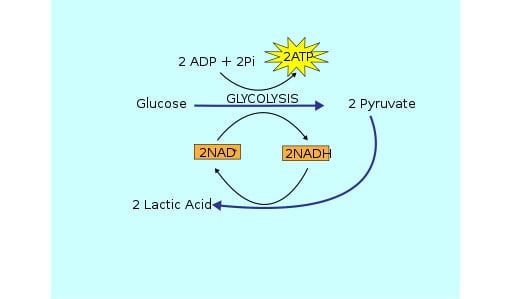Lactic acid is produced when the muscles don’t get enough oxygen to create energy through aerobic respiration. Long periods of intense exercise can lead to a buildup of lactic acid due to the extended time of oxygen shortage to the muscles.
The health and exercise industry is all about getting the most out of your workouts. That includes the best ways to rest and let your body recover from the stress of exercising. Invariably, many exercise and fitness blogs will mention lactic acid, its accumulation in the muscles, and its effect on performance.
What exactly is lactic acid and why do we only produce it when we exercise?

Recommended Video for you:
What Is Lactic Acid?
Everything is made of chemicals, a series of atoms joined to each other to create molecules. Lactic acid is a molecule composed of atoms of carbon, hydrogen and oxygen, like many other organic molecules. It is an acid, which means that it changes the pH of its surroundings by donating a proton (H+ ion) to the water.
Bacteria and microbes that ferment foods, the same ones that convert sugar into alcohol, are also responsible for creating lactic acid. These microbes ferment when there is a lack of oxygen, meaning that they are anaerobic.
This fermentation is a way for the microbes to produce energy. They eat the sugar and then, through a series of chemical reactions (called metabolic pathways), that sugar is broken down to produce energy. This is similar to how burning wood creates heat energy that you can use to cook your food (cooking could be considered as work being done by the fire on the food).
However, humans—and by extension our muscles—are not anaerobic microbes. We breathe in oxygen and breathe out carbon dioxide. In that case, how does lactic acid end up in our muscles?
How Do Cells (Muscles) Produce Energy?
For living organisms, energy comes in the form of a molecule—ATP. Commonly called the energy currency of the cell, the cell chemically spends ATP (by breaking the chemical bond and releasing energy) to get work done, similar to how you might spend money for a service.
Humans, and aerobic organisms, need oxygen to produce ATP. When the body has a plentiful and healthy supply of oxygen, the muscles (and other cells in the body) break up glucose to produce energy in a process called glycolysis (glyco = glucose and lysis = break up). The process of glycolysis produces some ATP, and a molecule called pyruvate (pie-roo-vate).

That said, the cell can get much more ATP by sending the pyruvate molecule to the mitochondria. The mitochondria is called the powerhouse of the cell for a good reason; it is equivalent to a power plant in a city. One of the mitochondria’s primary purposes in the cell is to create ATP and supply it to the rest of the cell. It is here, in the mitochondria, that oxygen is involved in creating energy.
This entire process, from glycolysis to the chemical reactions in the mitochondria, is called cellular respiration; you can read more about it here!
How Do Muscles Produce Energy Without Oxygen?
Now, when you’re running (either on a treadmill or away from a saber-toothed tiger), there isn’t enough oxygen for your muscles to keep pace with this intense activity for too long. However, the body needs energy, so the muscle cells initiate their emergency backup plan – lactic acid production.
With a shortage of oxygen, the mitochondria’s energy production line slows down and it is unable to produce enough ATP to fuel the overworked muscles.
So the cell, rather than sending the pyruvate to the mitochondria, converts pyruvate to lactic acid. This conversion doesn’t directly create ATP, but it allows glycolysis to continue to occur, which generates ATP.
For Those Who Want Biochemistry Details
How does converting pyruvate into lactic acid help glycolysis continue? This is because of a chemical called NAD. During several chemical reactions of glycolysis, the NAD (Nicotineamide adenine dinucleotide) accepts electrons, converting into NADH. In the presence of oxygen, this NADH would end up in the mitochondria and help generate energy. However, with little oxygen, the NADH can’t do much.

At the same time, the amount of NAD present in the cell is decreasing. Without NAD, the cell cannot continue to accept electrons during glycolysis, so the process stops. However, the reaction that converts pyruvate to lactic acid converts NADH to NAD, thereby increasing the concentration and allowing glycolysis to continue to produce ATP, which the muscle cell can use to do work.
Why Does Lactic Acid Accumulate In The Muscles When You Exercise?
When you exercise for long durations, the muscles continue to experience the lack of oxygen, so they keep creating more lactic acid. This quick and easy form of energy keeps your muscles pumping, but also leads to lactic acid accumulating in the muscles.
Why Is Lactic Acid Accumulation In The Muscles Bad?
There’s a fine balance of chemicals within cells and disrupting the chemical balance leads to cell malfunctioning (and in some cases, dying). Lactic acid is an acid that can disturb the normal pH of the muscle. Now, you’ve probably guessed where I’m heading with this. This disruption was thought to lead to muscle tissue experiencing fatigue, meaning that lactic acid compromises the normal functioning of the tissue.
In contradiction to this, several studies have not found a significant enough connection between lactic acid accumulation and muscle fatigue. Some researchers have suggested that potassium ions exiting the muscle cells is the cause for muscle fatigue, while others have suggested that exercise-induced injury and subsequent inflammation was the reason for the pain.
Thus, the jury is still out on whether lactic acid has any role in muscles and how well they function!
References (click to expand)
- (1986) Muscle fatigue and lactic acid accumulation. The United States National Library of Medicine
- Westerblad, H., Allen, D. G., & Lännergren, J. (2002, February). Muscle Fatigue: Lactic Acid or Inorganic Phosphate the Major Cause?. Physiology. American Physiological Society.
- Nielsen, O. B., Paoli, F., & Overgaard, K. (2001, October). Protective effects of lactic acid on force production in rat skeletal muscle. The Journal of Physiology. Wiley.
- Control of Lactic Acid Metabolism in Contracting Muscles... : Exercise and Sport Sciences Reviews - journals.lww.com













